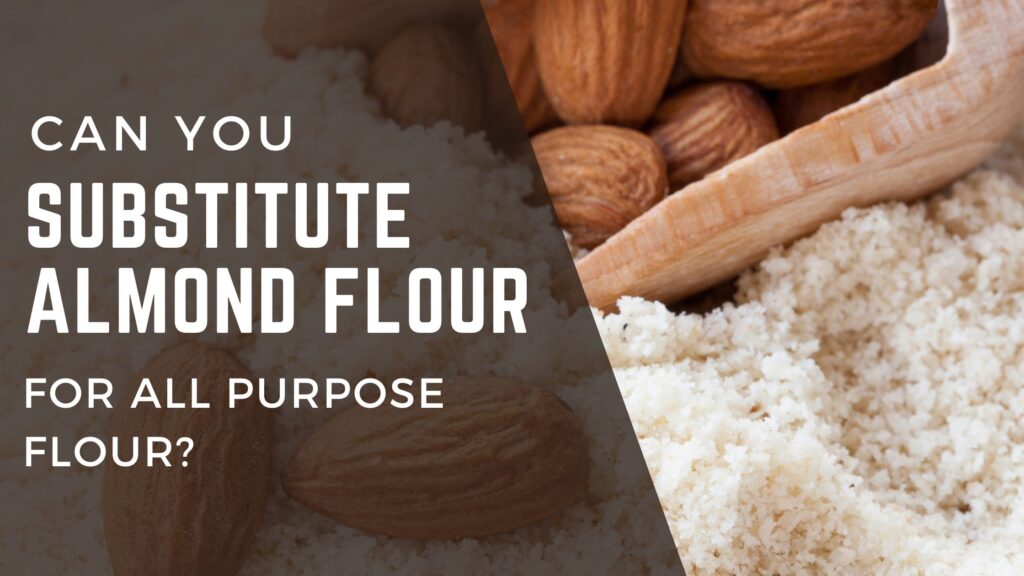Are you looking for a healthier alternative to all-purpose flour? Almond flour is a popular option that many people turn to for its nutritional value and gluten-free properties. But can you substitute almond flour for all-purpose flour in all your recipes?
While almond flour can be an excellent substitute for all-purpose flour in some recipes, it’s not always a one-to-one replacement.
Almond flour is denser and has a higher fat content, affecting the texture and taste of your baked goods. Before making the switch, understanding the differences between the two flours and how they behave in different recipes is essential.

Substituting Almond Flour for All-Purpose Flour
Almond flour can be a great option if you are looking for a gluten-free alternative to all-purpose flour. It is made from ground almonds and has a slightly nutty flavor. However, it is essential to note that almond flour does not behave the same way as all-purpose flour in baking.
How to Substitute Almond Flour for All-Purpose Flour
When substituting almond flour for all-purpose flour, remember that almond flour is denser and more moist than all-purpose flour.
As a result, you will need to adjust the amount of liquid in your recipe. Here is a general rule of thumb for substituting almond flour for all-purpose flour:
- Use 1 cup of almond flour for every 1 cup of all-purpose flour.
- Add an extra egg or binding agent to every cup of almond flour.
- Reduce the amount of liquid in the recipe by about 1/4 cup for every cup of almond flour.
It is also important to note that the higher fat content in almond flour can affect the texture and flavor of your baked goods.
You may need to adjust the baking time and temperature to ensure that your baked goods cook evenly.
Tips for Baking with Almond Flour
Here are some additional tips for baking with almond flour:
- Store almond flour in an airtight container in the refrigerator or freezer to prevent it from going rancid.
- Use almond flour in recipes that call for a nutty flavor, such as cookies, cakes, and breads.
- If you are new to baking with almond flour, start with a recipe developed explicitly for almond flour to ensure the best results.
All-Purpose Flour vs. Almond Flour
Differences Between All-Purpose Flour and Almond Flour
When baking, flour is one of the most essential ingredients. All-purpose flour is a versatile and commonly used flour in baking, while almond flour is a gluten-free alternative that has become increasingly popular in recent years. Here are some key differences between the two:
- All-purpose flour is made from wheat, while almond flour is made from ground almonds.
- All-purpose flour contains gluten, while almond flour is gluten-free.
- All-purpose flour has a neutral flavor, while almond flour has a nutty flavor.
- All-purpose flour has a higher carbohydrate content, while almond flour has a higher fat content.
When to Use Almond Flour Instead of All-Purpose Flour
Almond flour is an excellent option if you’re looking for a gluten-free alternative to all-purpose flour. It’s also a good choice if you’re looking for flour with a nutty flavor.
Here are some situations where you might want to use almond flour instead of all-purpose flour:
- Making gluten-free baked goods, such as cookies, cakes, and muffins.
- When you want a nutty flavor in your baked goods, such as in almond flour pancakes or almond flour bread.
- When adding more healthy fats to your baked goods, almond flour has a higher fat content than all-purpose flour.
However, it’s important to note that almond flour doesn’t behave the same way as all-purpose flour in baking.
Almond flour doesn’t contain gluten, which means it won’t rise in the same way as all-purpose flour.
This can result in denser baked goods. It’s also more expensive than all-purpose flour, so it may not be the best choice for everyday baking.
Recipes Using Almond Flour
Almond flour is an excellent option if you are looking for gluten-free alternatives to all-purpose flour. It is low in carbohydrates and high in protein. Here are a few recipes that use almond flour:
Bread
Almond flour bread is an excellent option for those on a low-carb or gluten-free diet. It is easy to make and can be enjoyed as a sandwich or toast. Here is a simple recipe for almond flour bread:
- 2 cups almond flour
- 1/4 cup coconut flour
- 1/4 cup psyllium husk powder
- 1 tsp baking powder
- 1/2 tsp salt
- 4 large eggs or Flaxseed egg
- 1/4 cup olive oil
- 1/2 cup warm water
Instructions:
- Preheat the oven to 350°F.
- Mix the almond flour, coconut flour, psyllium husk powder, baking powder, and salt in a large bowl.
- Whisk the eggs, olive oil, and warm water separately.
- Add the wet ingredients to the dry ingredients and mix until well combined.
- Pour the batter into a greased loaf pan and smooth out the top.
- Bake for 45-50 minutes or until a toothpick inserted in the center comes clean.
- Let the bread cool completely before slicing.

Cookies
Almond flour cookies are a great alternative to traditional cookies. They are soft, chewy, and have a nutty flavor. Here is a simple recipe for almond flour cookies:
- 2 cups almond flour
- 1/2 cup coconut sugar
- 1/4 cup melted coconut oil
- 1 large egg or flaxseed egg
- 1 tsp vanilla extract
- 1/2 tsp baking soda
- 1/4 tsp salt
Instructions:
- Preheat the oven to 350°F.
- Mix the almond flour, coconut sugar, baking soda, and salt in a large bowl.
- Whisk together the melted coconut oil, egg, and vanilla extract separately.
- Add the wet ingredients to the dry ingredients and mix until well combined.
- Scoop the dough onto a baking sheet lined with parchment paper.
- Flatten the dough with a fork.
- Bake for 10-12 minutes or until the edges are golden brown.
- Let the cookies cool on the baking sheet for 5 minutes before transferring them to a wire rack to cool completely.

Pancakes
Almond flour pancakes are an excellent option for those on a low-carb or gluten-free diet. They are fluffy, delicious, and easy to make. Here is a simple recipe for almond flour pancakes:
- 2 cups almond flour
- 1/2 tsp baking powder
- 1/4 tsp salt
- 2 tablespoon flaxseed egg
- 1/2 cup unsweetened almond milk
- 1 tsp vanilla extract
- 1 tbsp honey (optional)
Instructions:
- Mix the almond flour, baking powder, and salt in a large bowl.
- In a separate bowl, whisk together the flaxseed egg, almond milk, vanilla extract, and honey (if using).
- Add the wet ingredients to the dry ingredients and mix until well combined.
- Heat a non-stick skillet over medium heat.
- Scoop the batter onto the skillet using a 1/4 cup measuring cup.
- Cook for 2-3 minutes on each side or until golden brown.
- Serve with your favorite toppings, such as fresh berries or maple syrup.
Can you substitute water for milk in pancakes?
Can I Substitute Almond Flour for All-Purpose Flour in Chocolate Chip Cookies?
Almond flour may be a good option if you’re looking for a healthier alternative to traditional all-purpose flour. However, when baking chocolate chip cookies, substituting almond flour for all-purpose flour may not always yield the same results.
One of the main differences between almond flour and all-purpose flour is its protein content. Almond flour contains more fat and less protein than all-purpose flour, which can affect the texture and structure of baked goods.
You may notice that the cookies are crumbly and slightly different when using almond flour instead of all-purpose flour in chocolate chip cookies.
Additionally, the cookies may spread more during baking due to the higher fat content in almond flour.
To help mitigate these issues, you may want to consider using a blend of almond flour and all-purpose flour in your chocolate chip cookie recipe.
Can I Substitute Almond Flour for Regular Flour in a Cake Recipe?
When it comes to baking, substituting almond flour for all-purpose flour in a cake recipe can be a bit tricky.
Almond flour is gluten-free, meaning it does not contain the protein that gives structure to baked goods. This can result in a crumbly or dense cake if not adequately balanced with other ingredients.
However, you can successfully substitute almond flour for all-purpose flour in a cake recipe with some adjustments. Here are some tips to keep in mind:
- Use a 1:1 ratio of almond flour to all-purpose flour. If the recipe calls for 1 cup of all-purpose flour, you should use 1 cup of almond flour.
- Add a binding agent. Since almond flour lacks gluten, adding a binding agent such as eggs or xanthan gum is essential to help hold the cake together.
- Use a leavening agent. Almond flour is denser than all-purpose flour, so use a leavening agent such as baking powder or baking soda to help the cake rise.
- Be mindful of the flavor. Almond flour is nutty and may not work well with all cake recipes. Consider using it in recipes that already have nutty or earthy flavors.
Substitute Almond Flour for All-Purpose Flour in Muffins
Almond flour can be a great option if you’re looking for a gluten-free alternative to all-purpose flour in your muffin recipe. Here’s what you need to know to make the substitution successfully.
Adjust the Ratios
You’ll need to adjust the ratios when substituting almond flour for all-purpose flour in muffins. Almond flour is denser than all-purpose flour, so you must use less. A good rule of thumb is to use 1/4 to 1/3 cups of almond flour for every cup of all-purpose flour in the recipe.
Add Binding Agents
Almond flour doesn’t have the same binding properties as all-purpose flour, so you must add a binding agent to your muffin recipe. Eggs are a joint binding agent, so you may need to add an extra egg or two to the recipe. You could add a tablespoon of ground flaxseed or chia seeds to the recipe to help bind the muffins together.
Add Flavor and Texture
Almond flour has a nutty flavor that can add a delicious twist to your muffins. You could also add other ingredients, such as shredded coconut or chopped nuts, to add more texture and flavor to your muffins. Just be sure to adjust the ratios of the other ingredients to compensate for the almond flour.
How does almond flour affect baking?
When you substitute almond flour for all-purpose flour in baking, it can significantly impact the final product. Here are a few ways almond flour affects baking:
- Texture: Almond flour is denser and heavier than all-purpose flour, meaning baked goods made with almond flour tend to be denser and more moist. This can be good for some baked goods, like brownies or muffins, but it may not work as well for others, like cakes or bread.
- Rise: Because almond flour doesn’t contain gluten, which helps dough rise and expand, baked goods made with almond flour may not rise as much as those made with all-purpose flour. This can lead to a flatter, denser finished product.
- Flavor: Almond flour has a distinct nutty flavor, which can add a delicious twist to baked goods. However, this flavor may not work well in all recipes, and some people may not enjoy the taste of almond flour.
When substituting almond flour for all-purpose flour in baking, it’s important to remember the differences in texture, rise, flavor, and nutrition. You can create delicious baked goods using almond flour with some experimentation and adjustment, but it may not work as well in every recipe.

Best Chickpea substitutes you should try